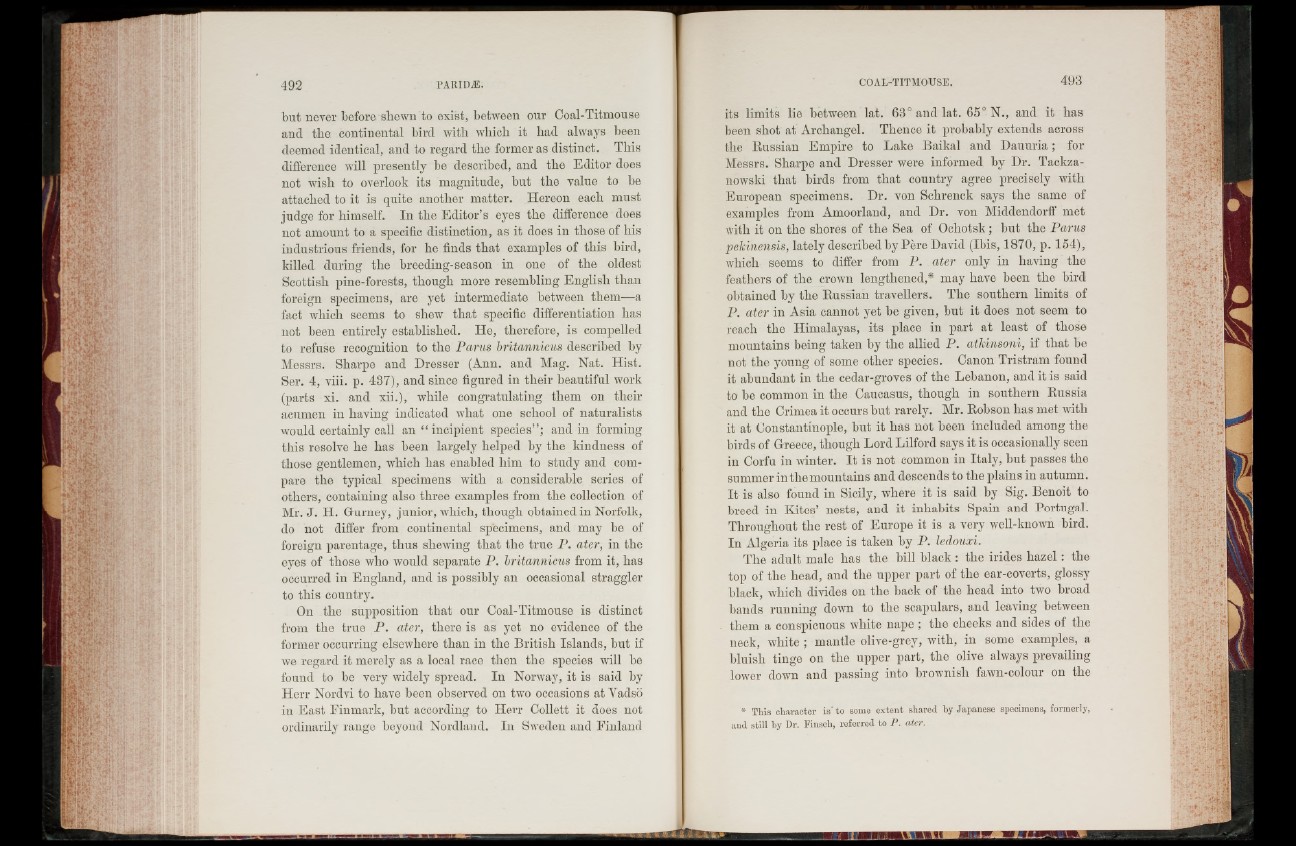
but never before shewn to exist, between our Coal-Titmouse
and tlio continental bird with which it had always been
deemed identical, and to regard the former as distinct. This
difference will presently be described, and the Editor does
not wish to overlook its magnitude, but the value to be
attached to it is quite another matter. Hereon each must
judge for himself. In the Editor’s eyes the difference does
not amount to a specific distinction, as it does in those of his
industrious friends, for he finds that examples of this bird,
killed during the breeding-season in one of the oldest
Scottish pine-forests, though more resembling English than
foreign specimens, are yet intermediate between them—a
fact which seems to shew that specific differentiation has
not been entirely established. He, therefore, is compelled
to refuse recognition to the Parus britannicus described by
Messrs. Sharpe and Dresser (Ann. and Mag. Nat. Hist.
Ser. 4, viii. p. 437), and since figured in their beautiful work
(parts xi. and xii.), while congratulating them on their
acumen in having indicated what one school of naturalists
would certainly call an “ incipient species” ; and in forming
this resolve he has been largely helped by the kindness of
those gentlemen, which has enabled him to study and compare
the typical specimens with a considerable series of
others, containing also three examples from the collection of
Mr. J . H. Gurney, junior, which, though obtained in Norfolk,
do not differ from continental specimens, and may be of
foreign parentage, thus shewing that the true P. ater, in tlio
eyes of those who would separate P. britannicus from it, has
occurred in England, and is possibly an occasional straggler
to this country.
On the supposition that our Coal-Titmouse is distinct
from the true P . ater, there is as yet no evidence of the
former occurring elsewhere than in the British Islands, but if
we regard it merely as a local race then the species will be
found to be very widely spread. In Norway, it is said by
Herr Nordvi to have been observed on two occasions atYadso
in East Finmark, but according to Herr Collett it does not
ordinarily range beyond Nordland. In Sweden and Finland
its limits lie between lat. 63° and lat. 65° N., and it has
been shot at Archangel. Thence it probably extends across
the Russian Empire to Lake Baikal and Dauuria ; for
Messrs. Sharpe and Dresser were informed by Dr. Tackza-
nowski that birds from that country agree precisely with
European specimens. Dr. von Schrenck says the same of
examples from Amoorland, and Dr. von Middendorff met
with it on the shores of the Sea of Ochotsk ; but the Parus
pekinensis, lately described by Père David (Ibis, 1870, p. 154),
which seems to differ from P. ater only in having the
feathers of the crown lengthened,* may have been the bird
obtained by the Russian travellers. The southern limits of
P. ater in Asia cannot yet be given, but it does not seem to
reach the Himalayas, its place in part at least of those
mountains being taken by the allied P. atkinsoni, if that be
not the young of some other species. Canon Tristram found
it abundant in the cedar-groves of the Lebanon, and it is said
to be common in the Caucasus, though in southern Russia
and the Crimea it occurs but rarely. Mr. Robson has met with
it at Constantinople, but it has not been included among the
birds of Greece, though Lord Lilford says it is occasionally seen
in Corfu in winter. It is not common in Italy, but passes the
summer in the mountains and descends to the plains in autumn.
It is also found in Sicily, where it is said by Sig. Benoit to
breed in Kites’ nests, and it inhabits Spain and Portugal.
Throughout the rest of Europe it is a very well-known bird.
In Algeria its place is taken by P. ledouxi.
The adult male has the bill black : the irides hazel : the
top of the head, and the upper part of the ear-coverts, glossy
black, which divides on the back of the head into two broad
bauds running down to the scapulars, and leaving between
them a conspicuous white nape ; the cheeks and sides of the
neck, white ; mantle olive-grey, with, in some examples, a
bluish tinge on the upper part, the olive always prevailing
lower down and passing into brownish fawn-colour on the
* This character is' to some extent shared by Japanese specimens, formerly,
and still by Dr. Finsch, referred to P. ater.